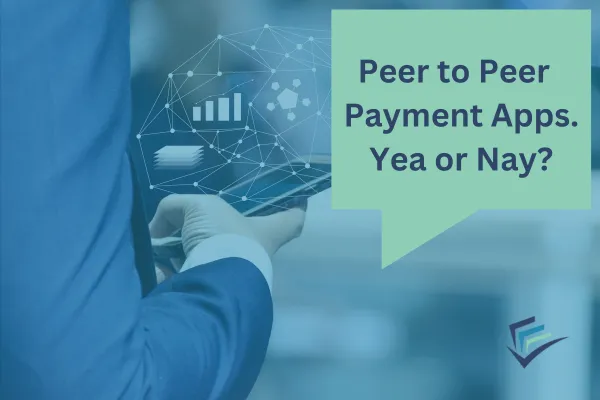Join Our Facebook Group!
The Books in Balance Blog

Can My Small Business Use Peer-to-Peer Payment Apps Like Cash App and Venmo?
“The art of simplicity is a puzzle of complexity.” - Douglas Horton
Introduction:
With the popularity of peer-to-peer payment apps gaining momentum, small business owners understandably question whether they should also make use of the technology for the added convenience it can be to their customers.
What are payment apps?
For the sake of this article, we are focusing on peer-to-peer payment apps that have gained popularity over the last couple of years and certainly through the contactless business transaction behavior shift in recent years. These apps, like Cash App, Venmo, and PayPal, allow users to send money from their mobile device through a linked bank account or card.
Other similar technologies and tools that manage credit card information and connect bank account details for effortless transfers and "swipe to pay" options include Google Pay, Apple Pay, and Samsung Pay. Social network Facebook even allows for payments through Messenger.
Cash App (Square)
Cash App is a mobile payment service developed by Square, Inc. where users sign up for a free account and choose a unique $cashtag, or username. Users then add funds to their Cash App account using a debit card linked to an existing bank account and choose simple prompts like "Request" or "Pay" to get the ball rolling. Cash App's website has plenty of details to share.

Venmo (PayPal)
Founded in 2009, Venmo is a similar peer-to-peer payment app owned by PayPal. While Cash App has the novelty of the $cashtag, Venmo offers a more social feel by publishing a running news feed of (willingly shared) transaction notes between your contacts. Oftentimes, friends will use emojis to indicate what transfers were for and then comment on each other's transaction details. There are fees tied to making payments using a linked card vs. a bank account that you can learn more about on Venmo’s FAQ page.

Zelle
In contrast to the other two discussed, Zelle only connects directly to bank accounts and does not charge any transaction fees. Zelle also has been integrated into several banking institutions for ease of access and more trustworthiness. If your banking institution does not offer Zelle transfers within their own system, the Zelle app is available to those users. Because the money transfers from bank account to bank account, there's no separate holding account for funds like with Cash App and Venmo. Learn more about how Zelle works.

Can I use them for my business?
The answer here is tricky. Your bank accounts and cards can certainly be connected to these accounts and used as intended. Depending on each company's terms of service, commercial usage might be discouraged or even prohibited. There are also steeper fees associated with commercial transactions as DepositAccounts.com explains about Cash App. Each app is different, but as Cash App states on their website they may issue IRS Form 1099-K to business account owners if you accept more than $20,000 in payments or 200 payment transactions during the year.
From Venmo’s Business Profiles Tax FAQ:
“In compliance with IRS regulation IRC 6050W, Venmo and other payment providers are required to report to the IRS the total payment volume received by business profile account holders whose payments meet or exceed both of these levels in a calendar year:
$20,000 USD in gross payment volume from sales of goods or services in a single year*, AND
200 payments for goods and services in the same year
*State Exceptions
For residents of Massachusetts, Vermont, and Virginia, the threshold is $600 USD, irrespective of the number of transactions
For Illinois residents, the threshold is $1,000 USD with 3 or more transactions ”
The reason the answer can be tricky is not just because policies, fees, and services differ. Whether a business utilizes a peer-to-peer payment app mostly depends on the organization, reporting, and reconciliation steps involved after the transaction occurs.
Take care in recording and reconciling these payments
When using peer-to-peer payment apps, it is important to record them properly in your accounting system. If the service carries a balance in your account that can be requested for transfer to your business bank account, you will need to have the payment account set up as a separate bank account to track the transactions and reconcile the balance using monthly statements just like any other bank account. If the app transfers funds directly between your business bank account and the other party, the transaction can be recorded directly to your regular account.
Other things to consider when using payment apps for business
Keep in mind that every password-protected app, tool, or platform your business uses poses a risk to information security. Because these apps are also connected to business bank accounts and credit card information, that risk increases exponentially. Be mindful of which employees have access and take proper, extensive precautions when managing this sensitive data.
Also remember that these apps are, in general, intended for personal use and that the account’s terms of service need to be understood and followed by both parties in the transaction. If a personal account is used for business transactions, the payment could be reversed by the processor whether or not the goods or services have been exchanged meaning you could lose both the payment and the item.
Complication for the sake of simplification
With access to new, shiny apps and tools that promote ease of use and a "quicker, easier way to send and receive money," keep processes in mind. If adding a new payment option means adding new reporting, organization, and monitoring responsibilities, the transaction time saved could be negligible. Consider all the new post-transaction steps involved when adopting a payment option like peer-to-peer apps.
Information, features, and policies for tools like these change frequently. Please visit the Cash App, Venmo, and Zelle websites to get the most updated information about their services. And if you're looking for advice about how to better structure your business' financial operations, reach out to Lynnette Kiss at Books in Balance, LLC for a free consultation. We'll discuss your business goals and make sure our services are a perfect fit.
Copyright © 2025
BK Financial Services, LLC, Bay City, TX
(979) 475-9997




